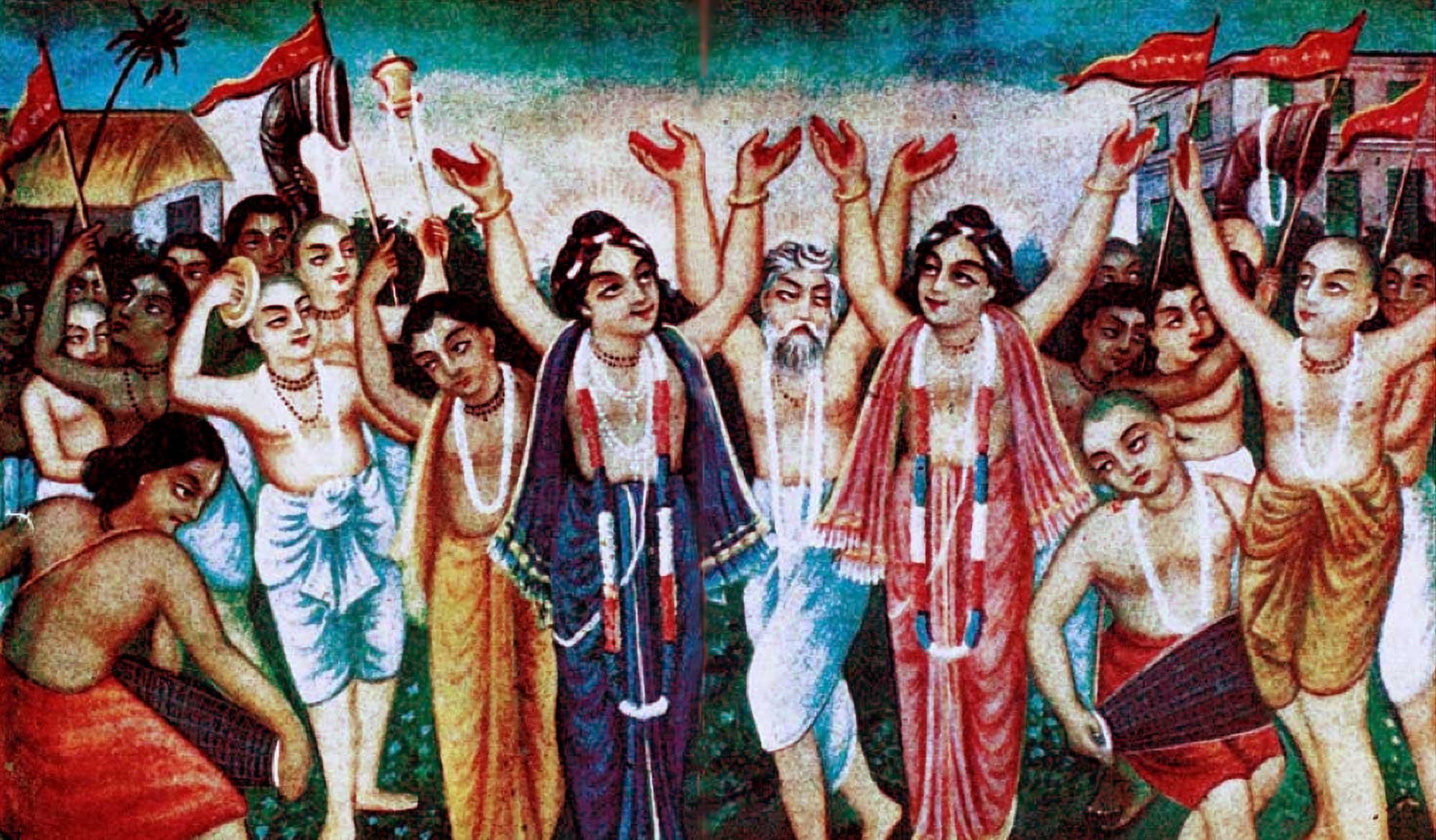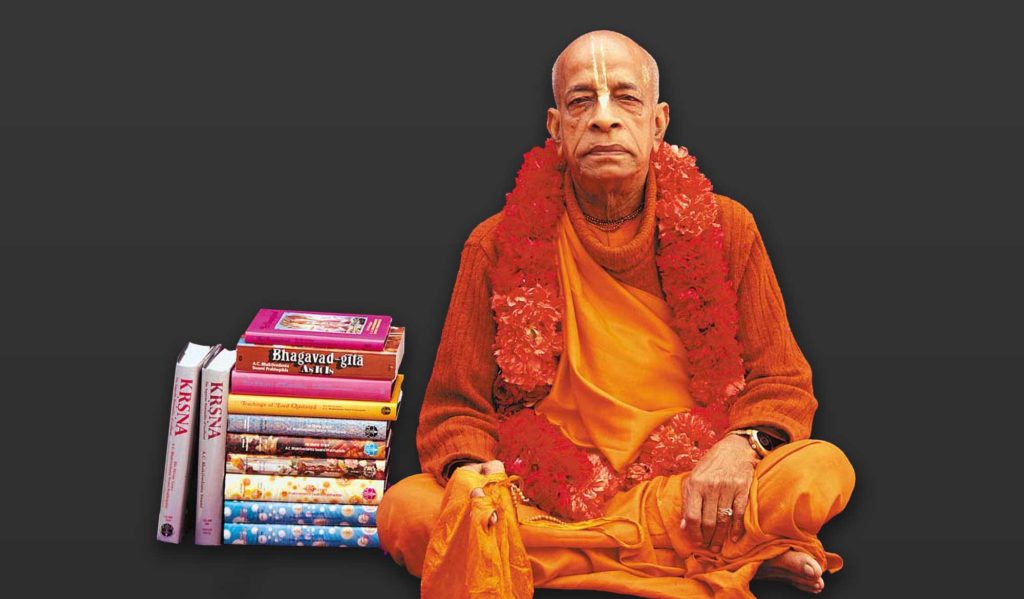Overview
'The Descent of the Holy Name' is the introduction to our book "The Descent of the Holy Name". The introduction is written by Śrīpāda Bhakti Kiśora Araṇya Mahārāja.
Nowadays, the word mantra is in common use by people in general, but its actual meaning is understood only by a few. The Sanskrit term mantra is comprised of two words – mana and tra. Mana meaning mind, refers to our perception of things based upon our conditioning due to the environment we find ourselves in, as well as the association we have accepted which is a result of the activities of our previous lives. These mould our mental states and subsequent prejudices through which we perceive the people and places around us. The word tra means to deliver us from such prejudices which have influenced our present mindset, bringing us to a higher state of divine consciousness.
In the śāstra, the ancient authoritative texts of Bhārata (presently known as India), there are many mantras that move us in such a divine direction. But just as there are gradations of gold – 24 karat, 22 karat, 18 karat etc. there are also different gradations of divine mantras.
However, in the present age known as Kali-yuga, which began over 5000 years ago, Śrīmad Bhāgavatam, the most authorised scripture, recommends the following process:
nāma saṅkīrtanaṁ yasya sarva pāpa pranāśanam
pranāmo duḥkhaśamanas taṁ namāmi hariṁ param
“I offer my respects unto Lord Hari, the congregational chanting of whose Names destroys all reactions to sinful activities, and the offering of obeisance unto whom relieves all material suffering.” – (Śrīmad Bhāgavatam 12.13.23)
The result of sinful actions is that we find ourselves encased within a particular body which we mentally and intellectually identify with. Thus the composite illusory conceptions arising out of such misidentification subjects us to repeated birth, disease, old age and death, and the natural affectionate ānanda (bliss) which is intrinsic to our very soul in relation to the Supreme Soul, Bhagavān Śrī Kṛṣṇa, is concealed.
The divine Name of Kṛṣṇa descends via His designated agent who acts as a conduit between the Supreme Lord and His eternal parts and parcels in order to reconnect the baddha-jīva (conditioned souls) back to his original position as an eternal loving servant in any of the multifarious relationships that exist in the spiritual world.
The mantra of the divine Name, being identical with the Lord, when received through His authorised agent and chanted by the sincere practitioner according to the rules and regulations directed by the bona-fide mantra-giver, reveals Himself according to the heartfelt sincerity of the practitioner in recognisable stages outlined in the śāstra, culminating in prema (pure love of God). That mantra, called the Mahā-mantra –
Hare Kṛṣṇa Hare Kṛṣṇa Kṛṣṇa Kṛṣṇa Hare Hare
Hare Rāma Hare Rāma Rāma Rāma Hare Hare
– is the most potent and recommended mantra in this iron age of Kali-yuga, as shown by the Supreme Lord Himself, incarnating as a devotee to show the mass of people the process of attaining prema-bhakti to Himself. This was demonstrated 500 years ago by the Kali-yuga avatāra, Śrī Caitanya Mahāprabhu, who travelled the length and breadth of Bhārata propagating the yuga-dharma (the spiritual practice of this age) of Kali-yuga – nāma-saṅkīrtana, the congregational chanting of the Hare Kṛṣṇa Mahā-mantra.
This series of articles by pure stalwart followers of Śrī Caitanyadeva gives the essence of the meaning and method of the descent of the Holy Name upon the fallen souls of Kali-yuga, and the method of receiving and distributing the Mahā-mantra to all who are willing to take part in this divine process of nāma-saṅkīrtana.
Related Articles
- Śrī Nāma Māhātmya (The Glories of the Holy Name) by Śrīla Bhakti Rakṣaka Śrīdhara Deva Gosvāmī
- Questions and Answers on Nāma-Tattva by Śrīla Bhakti Gaurava Narasiṅgha Mahārāja
- The Mahā Mantra by Śrīla Bhakti Gaurava Narasiṅgha Mahārāja
- Meditation Techniques and the Holy Name by Śrīla Bhakti Gaurava Narasiṅgha Mahārāja
- Meditation and the Holy Name by Śrīla Bhakti Gaurava Narasiṅgha Mahārāja
- Chanting the Holy Name by Śrīla Bhakti Gaurava Narasiṅgha Mahārāja
- The Descent of the Holy Name by Śrīla Bhakti Kiśora Āraṇya Mahārāja
Further Reading
Pilgrimage with Swami Narasiṅgha – Part 7: Keśī Ghāṭa
Continuing with our pilgrimage series, this week Śrīla Narasiṅgha Mahārāja takes us to Keśī Ghāṭā where he tells us about Madhumaṅgala’s meeting with the Keśī demon, what Keśī represents, and how Śrīla Prabhupāda almost acquired Keśī Ghāṭa. Mahārāja also narrates his own experience. This article has been adapted from a number of talks and articles by Narasiṅgha Mahārāja.
Prema Dhāma Deva Stotram with the Narasiṅgha Sevaka Commentary – Verses 61-65
In verses 61 to 65 of 'Prema Dhāma Deva Stotram', Śrīla Śrīdhara Mahārāja narrates the pastime of Śrī Caitanya at Caṭaka Parvata In Purī and explains how the scriptures produced by Brahmā and Śiva are ultimately searching for the personality of Mahāprabhu who is merciful too all jīvas, no matter what their social position.
Prabhupāda Śrīla Sarasvatī Ṭhākura’s Visit to Ayodhyā
With the forthcoming observance of Śrī Rāma Navamī, we present 'Prabhupāda Śrīla Sarasvatī Ṭhākura’s Visit to Ayodhyā' written by Śrīla Bhaktisiddhānta Sarasvatī Ṭhākura Prabhupāda from The Gaudīyā magazine, Vol 3. Issue 21/ In December 1924, after visiting Benares and Prāyāga, Sarasvatī Ṭhākura visited the birth-site of Śrī Rāmācandra in Ayodhyā.
Śaraṇāgati – The Only Path to Auspiciousness
In this article, 'Śaraṇāgati - The Only Path to Auspiciousness', Dhīra Lalitā Dāsī analyses the process of śaraṇāgati (surrender) beginning with śraddhā (faith). She also discusses the role of śāstra and the Vaiṣṇava in connection with surrender.
Pilgrimage with Swami Narasiṅgha – Part 7: Keśī Ghāṭa
Continuing with our pilgrimage series, this week Śrīla Narasiṅgha Mahārāja takes us to Keśī Ghāṭā where he tells us about Madhumaṅgala’s meeting with the Keśī demon, what Keśī represents, and how Śrīla Prabhupāda almost acquired Keśī Ghāṭa. Mahārāja also narrates his own experience. This article has been adapted from a number of talks and articles by Narasiṅgha Mahārāja.
Prema Dhāma Deva Stotram with the Narasiṅgha Sevaka Commentary – Verses 61-65
In verses 61 to 65 of 'Prema Dhāma Deva Stotram', Śrīla Śrīdhara Mahārāja narrates the pastime of Śrī Caitanya at Caṭaka Parvata In Purī and explains how the scriptures produced by Brahmā and Śiva are ultimately searching for the personality of Mahāprabhu who is merciful too all jīvas, no matter what their social position.
Prabhupāda Śrīla Sarasvatī Ṭhākura’s Visit to Ayodhyā
With the forthcoming observance of Śrī Rāma Navamī, we present 'Prabhupāda Śrīla Sarasvatī Ṭhākura’s Visit to Ayodhyā' written by Śrīla Bhaktisiddhānta Sarasvatī Ṭhākura Prabhupāda from The Gaudīyā magazine, Vol 3. Issue 21/ In December 1924, after visiting Benares and Prāyāga, Sarasvatī Ṭhākura visited the birth-site of Śrī Rāmācandra in Ayodhyā.
Śaraṇāgati – The Only Path to Auspiciousness
In this article, 'Śaraṇāgati - The Only Path to Auspiciousness', Dhīra Lalitā Dāsī analyses the process of śaraṇāgati (surrender) beginning with śraddhā (faith). She also discusses the role of śāstra and the Vaiṣṇava in connection with surrender.








